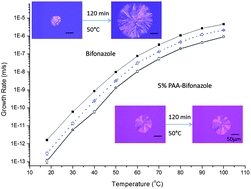Influence of polymer chemistry on crystal growth inhibition of two chemically diverse organic molecules†
Abstract
The purpose of this study was to understand how different

* Corresponding authors
a Department of Industrial and Physical Pharmacy, College of Pharmacy, Purdue University, West Lafayette, Indiana, USA
b Laboratory for Pharmacotechnology and Biopharmacy, K. U. Leuven, Gasthuisberg O&N2, Herestraat 49, Box 921, Leuven, Belgium
The purpose of this study was to understand how different

 Please wait while we load your content...
Something went wrong. Try again?
Please wait while we load your content...
Something went wrong. Try again?
U. S. Kestur, B. Van Eerdenbrugh and L. S. Taylor, CrystEngComm, 2011, 13, 6712 DOI: 10.1039/C1CE05822C
To request permission to reproduce material from this article, please go to the Copyright Clearance Center request page.
If you are an author contributing to an RSC publication, you do not need to request permission provided correct acknowledgement is given.
If you are the author of this article, you do not need to request permission to reproduce figures and diagrams provided correct acknowledgement is given. If you want to reproduce the whole article in a third-party publication (excluding your thesis/dissertation for which permission is not required) please go to the Copyright Clearance Center request page.
Read more about how to correctly acknowledge RSC content.
 Fetching data from CrossRef.
Fetching data from CrossRef.
This may take some time to load.
Loading related content
